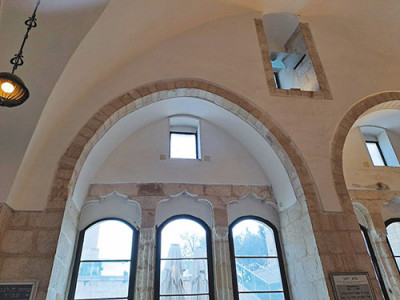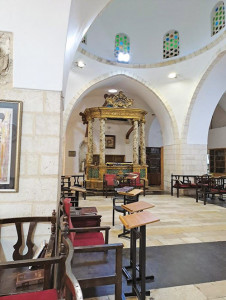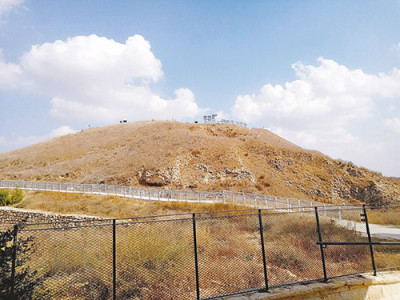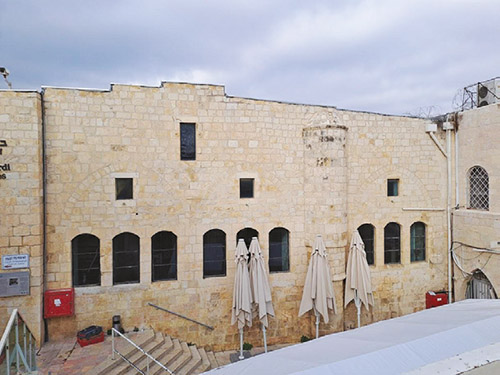
(Much of the historical information for this article was gleaned from Eyal Davidson’s book הרובע היהודי וכל נתיבותיו, published by Yad Yitzchak ben Tzvi.)
Let’s go back in time to the end of the 16th century in Yerushalayim. The land of Israel is under Ottoman rule. The Ottoman Empire was Muslim and ruled according to Muslim religious law (at least at that stage). According to Islam, Jews and Christians have the status of dhimmis, a kind of second-class citizen. They do not need to be forcibly converted to Islam, however, they cannot enjoy the same rights and privileges as a Muslim. One facet of their status was that they could not build new houses of worship.
So what did the Jewish community do when they needed to expand? They built their new synagogue down low, in a very unobtrusive manner. From the outside, this doesn’t look impressive at all. You can even see a niche in the external facade of the building. Perhaps that was intended to look like a mihrab, the part of a mosque that faces Mecca, to further alleviate tensions with the local Muslims.
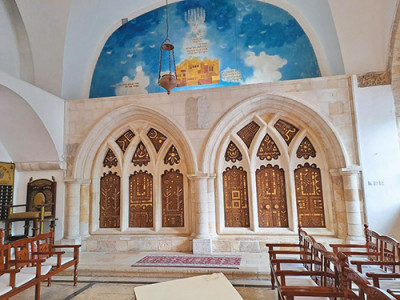
Once we step inside, however, we can’t help but be awed by the grandeur of this synagogue. This was the main Sephardic synagogue of Yerushalyim, perhaps from as early as the 13th century, although the exact date of its foundation is uncertain. This complex is actually divided into four unique synagogues, the oldest of which is called Raban Yochanan ben Zakkai, based on a tradition that this was the location where the rabbi prayed or studied. This structure could not be as old as Raban Yochanan ben Zakkai, the Jewish sage who had the foresight to save the Sanhedrin at the time of destruction of the second Beit Hamikdash and relocate to Yavneh. But he could very well have prayed in this location.
There are a few interesting things to note inside the Raban Yochanan ben Zakkai Synagogue. Interestingly, there are two Aronot Kodesh. One holds sifrei Torah and one holds other holy books. Another interesting thing that can be seen, if one strains one’s neck almost up to the ceiling, is a glass shelf on which sits a jug of oil and a shofar. What are they for? First, we must understand that this synagogue was completely destroyed by Jordan between the years 1948 and 1967. The synagogue we now see has been reconstructed based on old photographs. The original synagogue also housed a jug of oil and shofar, which legend said were from the time of the Beit Hamikdash. It was believed that the shofar was being saved to herald the coming of Mashiach and the oil to anoint him. But, there is perhaps a less esoteric explanation to these items that were kept in the synagogue. It is likely that this was the common oil used to create joint ownership of the area and thus allow carrying on Shabbat—a part of the eruv.
If we walk right next door, we find ourselves in the second synagogue, known as “Eliyahu HaNavi.” How did this synagogue get its name? Legend says that it was Yom Kippur and the Jews of Yerushalayim were one man short of a minyan. All of a sudden, a stranger appeared at the door and completed their minyan for the holiest day of the year. After the fast, the man disappeared! The constituents were convinced that their visitor was none other than Eliyahu HaNavi who had graced them with his presence. The chair that he sat on was actually saved in a special niche at the edge of the room and people seeking salvation would sit on it and pray. (Unfortunately, that chair was lost with the fall of the Jewish quarter in 1948. The chair we can see now is a replica designed based on old pictures.)
The third synagogue is called “The Middle One,” as it is located in the middle of the others. Originally, it was just a corridor (or perhaps a women’s section for the Raban Yochanan ben Zakkai Synagogue). In 1733, it was inaugurated as a separate synagogue to accommodate the growing population of Yerushalayim.
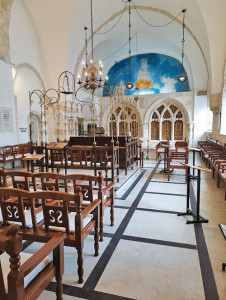
As the population of Yerushalayim continued to grow, a fourth synagogue was built and called “the Istanbuli,” probably because it was specifically for the Sephardim who had come from Istanbul or Turkey. Although the original synagogue was destroyed in 1948, today’s synagogue is graced with a beautiful and ornate Aron Kodesh and bimah from two different Jewish communities in Italy.
As we explore the beauty of these gorgeous synagogues that have been restored since 1967, we can almost hear the prayers and Torah learning of the Sephardic community of Yerushalayim echo through the walls. We connect to hundreds of years of the Jewish community of Yerushalayim, living with faith and praying to herald the coming of Mashiach!
Recognize this place? Be the first to email the correct answer to havapreil@gmail.com and receive a free drink at Lazy Bean Cafe in Teaneck! Stay tuned to learn more about it in our next article.
Hava Preil is an enthusiastic licensed Israeli tour guide. She grew up on the Upper West Side of Manhattan and holds an MA in Judaic studies. Hava has developed and taught accredited courses in Tanach and Jewish ethics for Naaleh/Woodmont College and Cybersem. She currently lives in Givat Ze’ev, Israel with her family. Hava can be reached at IL: 054-844-1579, USA: 845-391-0438 or at Havapreil@gmail.com
